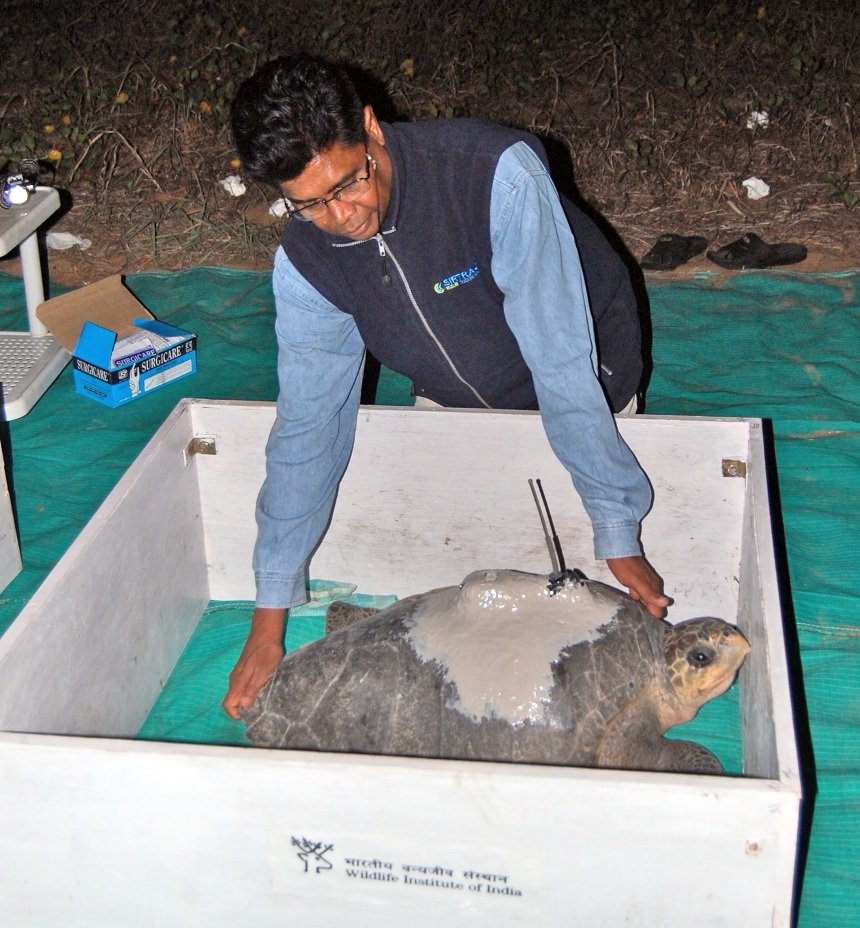B. C. Choudhury
This post is part of our Living Legends series that spotlights key people in sea turtle conservation.
B. C. at the sea turtle beaches of Odisha, India, where he and his team tagged and tracked thousands of turtles.
Biography
B. C. Choudhury started his sea turtle career in 1975 with the Odisha (India) Forest and Wildlife Department, then with the states of Tamil Nadu and Andhra Pradesh, and ultimately with the Wildlife Institute of India (WII). He was associated with the turtle walk and egg collection program in Madras that became the Students Sea Turtle Network, which is still active, and he has overseen dozens of master’s and PhD dissertations on Indian sea turtles. In 1994, his team discovered the Rushikulya olive ridley rookery, and with his teams he has tagged more than 35,000 turtles and satellite tracked dozens more. He led the Indian National Sea Turtle Program, which surveyed the entire Indian coastline in the 2000s, and he edited a book on Marine Turtles of the Indian Subcontinent. B. C. was instrumental in mentoring a generation of leading sea turtle biologists and conservationists, and he continues to work on an array of policy, environmental impact assessments (EIAs), and conservation issues relating to sea turtles in and around India.
First Sea Turtle Moment
It was in 1975 at the Tuticorin beach in Tamil Nadu, when I went to explore rumors of the illegal sea turtle trade. We were told that one trader had cement ponds with green sea turtles, and that he sold turtle blood and meat almost every morning. We discovered several ponds with as many as 20 green turtles in each. So, we arrived at 04:30 the next day to witness the long line of buyers gather. Soon the animals arrived, and a handler deftly cut off their plastrons. Then the crowd filed past the struggling, living animals to dip their cups into the open viscera and ritualistically drink the blood before the rising sun with blind faith that it would cure and prevent respiratory illnesses. It was a ghastly scene and even after 47 years, the memory haunts me. Not long after, we shared images of the event with the Chief Wildlife Warden, and a days later the operation was shut down and the remaining turtles released.
Proudest Accomplishment
In 2006, my team and I were able to avert what could have been a disaster for the main sea turtle areas in northeast India by working with both the development and conservation communities to create a win-win scenario. The Petroleum Ministry of India had allocated large blocks of turtle habitat for hydrocarbon exploration, and oil companies had planned their seismic work right at the time when the arribadas might have occurred. My team advised that such timing was dangerous for turtles, and we asked for time and support to suggest better timing and protocols. The Petroleum ministry readily agreed and made a substantial grant to our work, and the oil companies provided a platform for research to be conducted on their vessels. We were able to train the oilmen in proper turtle avoidance and handling protocols, and help them avoid habitats important to the turtles. Our team started tagging during the 2007 nesting season, and from that work we were able to devise a framework for conducting turtle-safe ocean seismic surveys. This was approved by the Petroleum ministry, that then supported us for another three years during which we completed an excellent research effort that resulted in several peer reviewed papers and two PhD dissertations.
What is different now than when you started?
There were only 2 or 3 Indian researchers working on sea turtles when I began. By the 1980s, the Central Marine Fisheries Research Institute of India (CMFRI) started recording turtle mortalities at sea, but the agriculture ministry was unwilling to consider introducing TEDs (turtle excluder devices), so we were fighting a losing battle. Today, EIAs and SIAs are mandatory for any development work in sea turtle habitats, though the powerful development lobby continues to push against us. For instance, the Indian government, backed by industry, is still fighting to build a new port at Galathea, the key nesting site for leatherbacks in Nicobar Islands. The difference is that today there are more NGOs, researchers, and activists lobbying against such things.
What are you most hopeful (and worried) about?
I am hopeful that a portion of the Indian government now actually listens to science and responds to conservation issues. And I find hope from the large number of NGOs, media outlets and informed activists who support and lobby on behalf of nature. But I still worry about the government hard-liners whose only agenda appears to be economic development while they simultaneously shed crocodile tears.
What is your advice to people new to this field?
Do not lose hope! Fight for the cause even if no one seems to notice your voice. Reach out to media with informed activism. Keep science as the basis of your battle against the ill-informed and vested interest development lobby. It is not the glamour and the thrill of sea turtle research that should attract you, but the wellbeing of the marine environment and its creatures, and their conservation should be the reason you are entering the field.

